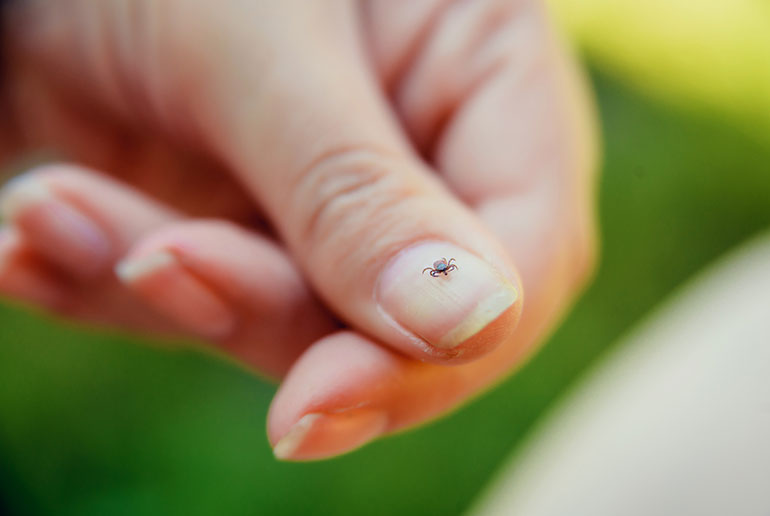Welcome to Sweden! Land of pristine lakes, breathtaking forests, and…ticks.
Sadly, it’s true: these tiny hitchhikers love the great Swedish outdoors as much as we do – and they can be pretty dangerous. So how worried should you be about picking up a tick or two on your trip to Sweden?

How big is the tick problem in Sweden?
Much like cinnamon buns and ice hockey, ticks are a very real part of life in Sweden.
These tiny arachnids are prevalent in most parts of the country, but in some areas (including those most popular with foreign tourists), the tick population has boomed in recent decades.
This means that, if you spend a significant amount of time in nature in Sweden, you’re likely to encounter ticks.
Why ticks can be dangerous
Sure, they look a bit creepy. And having your blood sucked by any creature is kind of unpleasant. But the real danger is that ticks in Sweden can spread serious diseases and make you very poorly.
Before we go any further, it’s important to remember that getting a tick bite doesn’t necessarily mean you’ll get ill. Not all ticks carry diseases, and most bites are harmless. Your risk of infection is also lower if you find and remove any ticks quickly.
However, there are two main illnesses that Swedish ticks carry, causing problems for Swedes and tourists alike.
Lyme disease, known by Swedes as Borrelia, is a relatively common disease that’s spread by tick bites. This bacterial infection can lead to fatigue, fever, headaches, and in more severe cases, neurological problems.
Borrelia is treatable with antibiotics if diagnosed early, so fast action is key if you suspect you’ve been bitten by a tick and are noticing symptoms. You can’t vaccinate yourself against lyme disease.
The TBE virus, although much less common, can also be transmitted by ticks and can lead to severe health problems. Fortunately, a vaccine against TBE is available and widely used in Sweden, particularly by those who live in or visit high-risk areas.

Which areas of Sweden have most ticks?
You’re not likely to encounter ticks in downtown Stockholm or Gothenburg, but pretty much all central and southern areas of the country have high tick populations.
Vastra Götaland (the area around Gothenburg) is home to one major hotspot, which stretches as far north as Karlstad and Karlskoga. There are also high numbers of ticks around Stockholm (including the archipelago), plus Uppsala, Norrköping and Linköping.
Rural areas are obviously worst affected, but you can actually get tick bites in just about any forest, woodland or area with long-ish grass – including people’s back gardens.
The Swedish Health Agency publishes maps showing the incidence of TBE and other tick-borne illnesses across Sweden.
Why are there so many ticks in Sweden?
Several factors contribute to the large tick population in Sweden.
The geography and climate of the country make it ideal for ticks, with ample forests, grasslands, and relatively mild weather conditions in the south of the country.
Ticks also require hosts to survive and reproduce. The abundance of wildlife in Sweden, particularly deer, provides a plentiful food source for these pests. Many of our city-dwelling friends in southern and western Sweden occasionally have deer visiting their gardens, bringing with them the dreaded ticks.
Another reason for Sweden’s high tick population is that they are incredibly resilient pests that have managed to thrive over the years, undeterred by occasional harsh winters, due to their ability to lie dormant and re-emerge during milder conditions.
When are ticks active in Sweden?
Ticks are most active between spring and early autumn (that’s roughly April to September), peaking in the summer months of June to August when the Swedish countryside is most inviting to both humans and animals alike.
Tips for avoiding ticks in Sweden
In some parts of Sweden, avoiding ticks altogether is hard. We know parents who regularly find multiple ticks on their kids after a day of playing outside, but stories of people getting ill are thankfully quite rare.
If you’re on a city break, simply keep to well-trodden paths in parks, check your clothing and shower quickly after a day out. You might also choose to avoid sitting directly on the grass.
For more adventurous holidays involving hiking or camping, invest in a tick remover (available from local pharmacies called ‘apotek’) and learn how to use it. Wear long trousers, preferably light-coloured so you can spot any ticks before they reach your skin. You might also consider tick-repellent clothing or sprays.
Are kids more at risk?
Young children, due to their love for playing in the grass or forest, are indeed more prone to tick bites. But with a little bit of adult assistance, they can still enjoy the great outdoors safely.
Teach them to stay on trails while playing (where possible!) and always check them for ticks after they’ve been playing outside (bath time is a good opportunity for this). Pay special attention to armpits, the back of knees and the area behind the ears, which are all favourite hiding places for ticks.
Remember that ticks in Sweden are very small to begin with (like tiny money spiders) and that they only increase in size once they have been feeding for a while.
What do the Swedes do about ticks?
Swedes, known for their love of nature and outdoor activities, have learned to coexist with ticks. Many opt for vaccination against TBE, especially those in high-risk areas. In fact, Sweden has one of the highest rates of TBE vaccination in the world.
While Swedes may appear unfazed by ticks, it doesn’t mean they ignore the risks. They remain vigilant, especially during the tick season, regularly check for ticks after spending time outdoors, and seek immediate medical attention if a tick bite shows signs of infection or leads to symptoms such as fever or fatigue.
How to remove ticks
It’s important to remove any ticks as soon as you find them.
You can do this with fine-tipped tweezers or a specialized tick removal tool (though the latter isn’t really necessary in most cases). Grasp the tick as close to the skin’s surface as possible and pull upward with steady, even pressure (don’t squeeze the tick too hard while it’s still attached).
After removing the tick, thoroughly clean the bite area with soap and water, rubbing alcohol, or an iodine scrub. Do not crush the tick with your fingers. Dispose of the tick by submerging it in alcohol, placing it in a sealed bag or container, or flushing it down the toilet.
When to get help
If you’re bitten by a tick in Sweden, don’t panic. Remove the tick as soon as possible and clean the area with soap and water. Remember, most ticks do not carry diseases, and most tick bites do not lead to disease.
However, if you develop a rash, especially a red ring around the bite site, experience flu-like symptoms, or the tick was attached for a long time, seek medical attention promptly. The local term for a health centre is ‘vårdcentralen’ and a pharmacy is called ‘apotek’ in Swedish. You can find these in all towns and cities in Sweden.
Try not to panic about ticks. With the right precautions, you can enjoy all that Sweden has to offer, tick-free. Remember, when in doubt, seek medical attention. Knowledge, vigilance, and a pair of long trousers are your best defence against ticks in Sweden.









